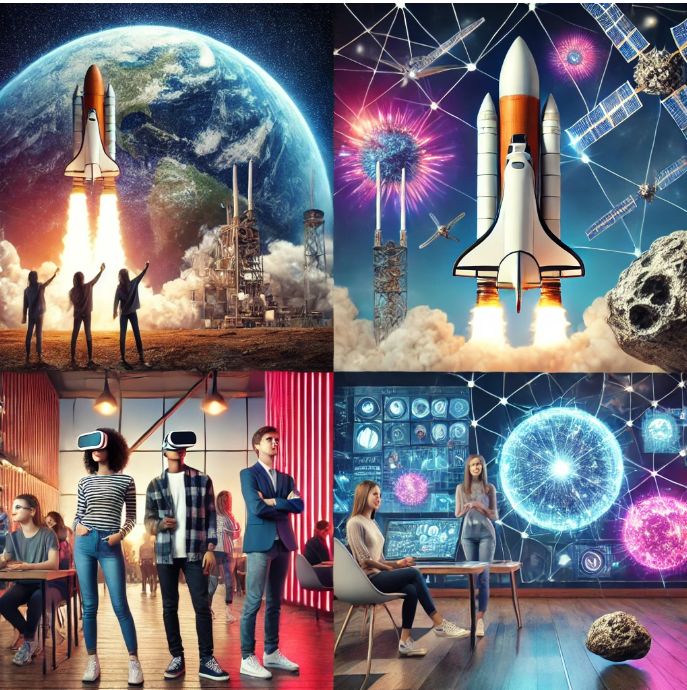
The aerospace industry is undergoing a profound transformation. As commercial space tourism, asteroid mining, and new space technology become more prominent, attracting the next generation of customers, innovators, and advocates is vital. Millennials and Gen Z, characterized by their tech-savviness, social consciousness, and penchant for innovation, present a unique challenge for aerospace companies. How can these companies effectively engage this audience? The answer lies in understanding their preferences, leveraging cutting-edge marketing strategies, and embracing themes that resonate deeply with their values.
Understanding Millennials and Gen Z
Millennials (born 1981-1996) and Gen Z (born 1997-2012) are digital natives. They’ve grown up in a world of rapid technological advancements, from smartphones to AI-driven applications. These generations value experiences over material possessions, making concepts like space tourism especially appealing. However, they are also deeply concerned about sustainability and ethics, which means aerospace companies must address these issues head-on to capture their attention.
1. Spotlight on Space Tourism
One of the most captivating aspects of modern aerospace is space tourism. Companies like SpaceX, Blue Origin, and Virgin Galactic are pioneering this frontier, turning the dream of traveling to space into a tangible reality. For Millennials and Gen Z, the allure of experiencing the cosmos firsthand is irresistible.
However, a critical barrier remains: space tourism cost. With current prices ranging from hundreds of thousands to millions of dollars per ticket, space tourism remains out of reach for most people. Aerospace companies must focus on:
- Creating aspirational marketing: Highlighting the life-changing potential of space travel through storytelling, immersive videos, and virtual reality experiences.
- Offering payment plans and contests: Introducing initiatives like monthly payment options or contests to win a seat can make space tourism seem more attainable.
- Communicating future affordability: Sharing plans to lower space tourism costs as technology evolves will keep younger audiences invested in the industry’s progress.
2. Promoting Sustainability in Space
Both Millennials and Gen Z are highly conscious of environmental issues. The rise in satellite launches and space debris has sparked concerns about the ecological impact of aerospace activities. Companies need to:
- Address environmental concerns: Highlight efforts to mitigate space debris, such as using reusable rockets or developing systems for debris removal.
- Emphasize green innovation: Show how advancements in new space technology contribute to sustainability. For instance, using cleaner fuels or creating satellites with minimal environmental footprints.
- Engage in transparent communication: Sharing detailed plans about sustainability initiatives builds trust with socially conscious audiences.
3. Leveraging Space Research and Technology
Aerospace companies are at the forefront of innovation, from developing asteroid mining possibilities to creating new satellite technologies. Millennials and Gen Z are fascinated by cutting-edge advancements, but they need to be presented in relatable ways. Strategies include:
- Showcasing tangible benefits: Highlight how space research leads to everyday innovations, such as improved GPS systems or advancements in medical technology.
- Fostering inclusivity in innovation: Partnering with educational institutions to involve young people in space-related projects can spark interest and loyalty.
- Hosting interactive events: Virtual conferences, webinars, and live Q&A sessions with astronauts or engineers can make space research more accessible and engaging.
4. The Allure of Asteroid Mining
Asteroid mining represents an exciting, albeit futuristic, frontier. The idea of harvesting resources from celestial bodies is straight out of science fiction but is being pursued by asteroid mining companies. To captivate Millennials and Gen Z, aerospace companies can:
- Present asteroid mining as a solution to Earth’s resource challenges: Frame the narrative around sustainability and the potential to alleviate resource scarcity.
- Incorporate gamification: Create interactive experiences, like apps or online simulations, to demonstrate how asteroid mining works and its potential impact.
- Highlight global collaboration: Millennials and Gen Z value inclusivity. Showcasing how asteroid mining requires international cooperation can resonate deeply.
5. Making Space Law Relevant
Space law may seem like an abstract concept, but it’s crucial for governing space activities. Aerospace companies can tap into Millennials’ and Gen Z’s sense of justice by:
- Educating audiences: Simplify complex topics like international space law or satellite regulations into digestible, engaging content.
- Advocating for ethical practices: Highlight the company’s commitment to adhering to space laws and promoting ethical space exploration.
- Engaging in social discourse: Participate in discussions about space laws on social media, addressing concerns and inviting feedback.
6. Social Media and Digital Strategies
For Millennials and Gen Z, social media is a primary source of information. Aerospace companies need to establish a robust online presence:
- Create shareable content: Videos, infographics, and memes about satellites launched, space tourism companies, and new space technology can go viral, spreading awareness.
- Collaborate with influencers: Partnering with tech influencers, science communicators, and space enthusiasts can amplify outreach.
- Utilize interactive platforms: Use Instagram polls, Twitter threads, and TikTok challenges to engage younger audiences.
7. Building Trust Through Transparency
Millennials and Gen Z are skeptical of corporate motives. To win their trust, aerospace companies must prioritize transparency:
- Share behind-the-scenes content: Documenting the development of space technology or satellite launches can humanize the company.
- Acknowledge challenges: Being honest about setbacks and efforts to overcome them demonstrates authenticity.
- Promote diversity: Showcasing a diverse workforce can inspire young people from various backgrounds to connect with the company’s mission.
8. Future-Ready Engagement
Finally, aerospace companies must ensure their strategies are future-focused. Gen Z, in particular, values innovation and staying ahead of the curve. Companies can:
- Introduce educational initiatives: Create programs that teach young people about space technology, asteroid mining, and space research.
- Develop immersive experiences: Virtual reality tours of spacecraft or asteroid mining simulations can capture imaginations.
- Involve young innovators: Hosting hackathons or idea competitions can directly engage the audience in shaping the future of aerospace.
Conclusion
Millennials and Gen Z are the future of the aerospace industry. By addressing their concerns, leveraging their digital habits, and creating compelling narratives around space tourism, asteroid mining, and new space technology, aerospace companies can build lasting connections. The key lies in authenticity, innovation, and inclusivity, ensuring that the next generation not only supports but also actively participates in humanity’s journey to the stars.
